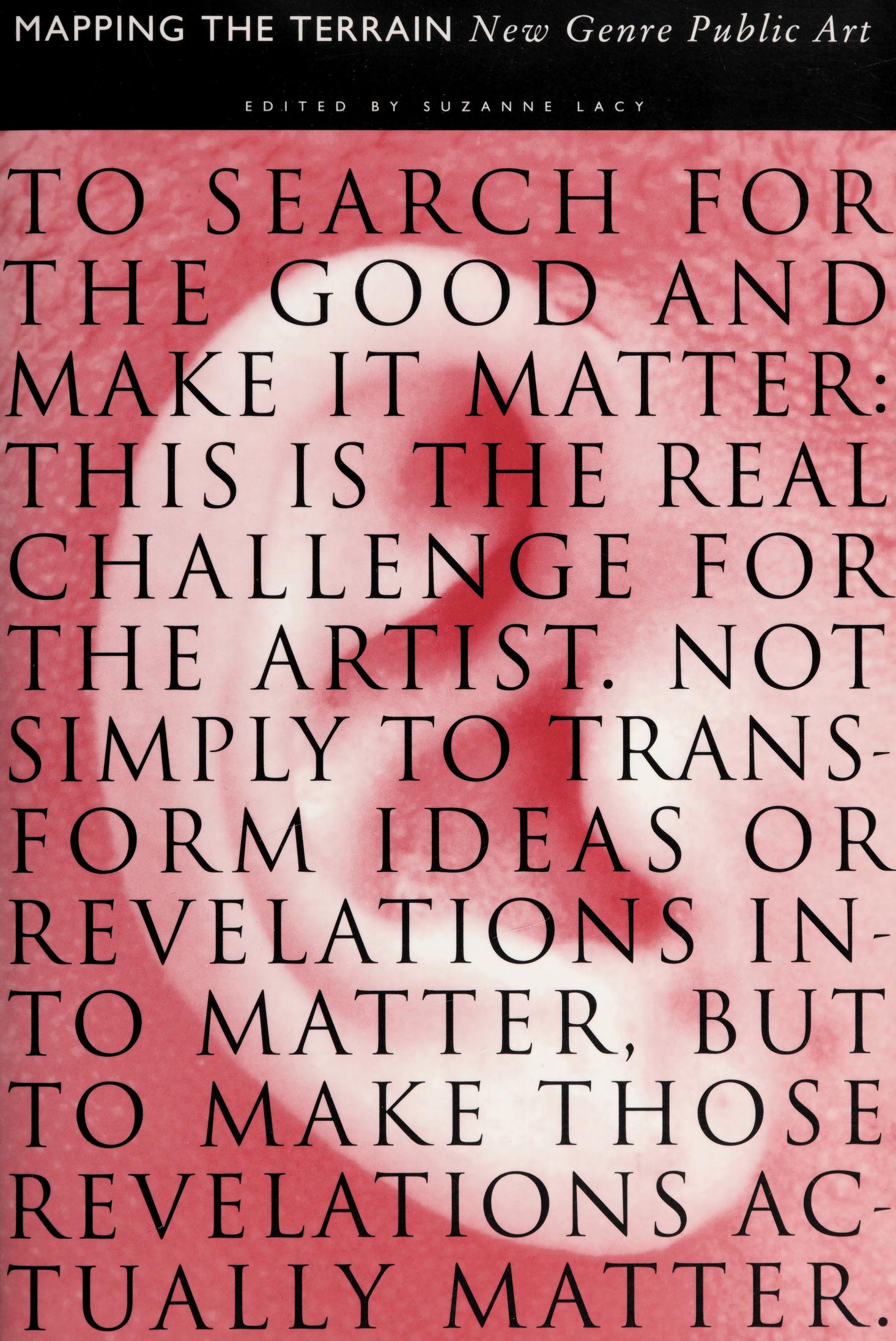Suzanne Lacy (ed.): Mapping the Terrain: New Genre Public Art (1995)
Filed under book | Tags: · aesthetics, art criticism, art history, community, community art, performance art, politics, public art

“Departing from the traditional definition of public art as sculpture in parks and plazas, new genre public art brings artists into direct engagement with audiences to deal with the compelling issues of our time. This is the first definitive collection of writings on the subject by critics, artists, and curators who are pioneers in the field. Includes essays by Judith Baca, Estella Conwill Májozo, Suzi Gablik, Guillermo Gomez-Pena, Mary Jane Jacob, Allen Kaprow, Jeff Kelley, Lucy Lippard, Patricia C. Phillips, and Arlene Raven.”
Publisher Bay Press, Seattle, 1995
ISBN 0941920305, 9780941920308
296 pages
Reviews: Kirkus Rev (1994), Gaye Green (Art J, 1999), Carole Gold Calo (Public Art Dialogue, 2012).
Commentary: Stephanie Smith (Afterall, 2011, PDF).
PDF (49 MB, updated on 2018-6-22)
Comment (0)Victor Tupitsyn: The Museological Unconscious: Communal (Post)Modernism in Russia (2009)
Filed under book | Tags: · art history, community, community art, conceptual art, contemporary art, factography, identity, photography, postmodernism, russia, socialist realism, sots art, soviet union, utopia

“In The Museological Unconscious, Victor Tupitsyn views the history of Russian contemporary art through a distinctly Russian lens, a “communal optic” that registers the influence of such characteristically Russian phenomena as communal living, communal perception, and communal speech practices. This way of looking at the subject allows him to gather together a range of artists and art movements–from socialist realism to its “dangerous supplement,” sots art, and from alternative photography to feminism–as if they were tenants in a large Moscow apartment.
Describing the notion of “communal optics,” Tupitsyn argues that socialist realism does not work without communal perception–which, as he notes, does not easily fit into crates when paintings travel out of Russia for exhibition in Kassel or New York. Russian artists, critics, and art historians, having lived for decades in a society that ignored or suppressed avant-garde art, have compensated, Tupitsyn claims, by developing a “museological unconscious”–the “museification” of the inner world and the collective psyche.”
With an Introduction by Susan Buck-Morss and Victor Tupitsyn
Publisher MIT Press, 2009
ISBN 0262201739, 9780262201735
x+341 pages
Reviews: Raoul Eshelman (ArtMargins 2009), Gillian McIver (a-n 2009), Alexander Etkind (Russian Review 2010), Sven Spieker (Slavic Review 2010), Lara Weibgen (ArtJournal 2011).
PDF (6 MB)
PDF chapters
continent. 4.3: Intangible Architectures (2015)
Filed under journal | Tags: · architecture, community, language, resistance, space, state

“This issue of continent. deals with the theme of intangible architectures. While in keeping with the theoretical and experimental nature of previous issues, this release intends a balance with an urgent grounding in current events, political schemas and areas of research that demand broadened dialogue. An underlying conversation represents some response to the tension that is enabled through systems that shape experience, behaviour and meaning – examining the imprints and traces that are left on our beings by these forms.
In some cases, this tension is manifest as social violence, where political and economic conditions are inseparable from the cultural expression of these structures. The idea of intangible architectures as political agents may relate to emergency states, militarised environments, questions of statehood and national borders, and the patterns of self-determining communities (Paul Boshears, Charles Stankievech, Ethel Baraona Pohl, César Reyes Nájera, Léopold Lambert). Architectures that are not yet constructed, and the rhetoric used to justify or oppose such development, are also revealing of the philosophy of private developers and communities of resistance (Lital Khaikin, Nathan Medema).
We may then find, after encountering these most immediate forms of intangible architectures, the spatial manipulations of social and intimate behaviour, laws, experiences, and memories. Architectural structures that do exist may yet conceal more complex frameworks, which exude laws that are autonomous to their initial, intended use. These subtle systems are encountered in liminal and transitory zones of city space, in artist-run exhibition spaces, in the homes that we recreate in our memories, in the emotional symbolism we create from structural space (Paolo Patelli, Giuditta Vendrame, Simone Ferracina, Sophie-Carolin Wagner, Tiara Roxanne).
But then, may we go deeper to find traces, mirrors of these intangible architectures, within language and more abstract experience of atmosphere? Do the systems by which we begin a construction of our understanding of the world – from phonemes to the cartographies that are charted in sonic atmosphere – not also shape our behaviours and relationships to space? (Kaie Kellough, Jason Sharp, Orit Halpern) In all cases, we are asked to consider the manifestations of structures that determine our experiences, interpretations and relationships to space. Let these be public or intimate – they engage the imagination equally, challenging us to think about the way these imprints affect our shared presence and relation to all beings.” (from Editorial)
Edited by Lital Khaikin, Paul Boshears, Jamie Allen, and Matt Bernico
Publisher continent., September 2015
Creative Commons Attribution 3.0 License
ISSN 2159-9920

